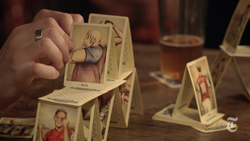
If you haven’t watched an Op-Doc piece on the online New York Times, you probably should. It’s not that I’ve been blown away by any one of those I’ve seen. But I really like the idea of them, and find myself going back to them because of it: a very short “doc” form that insists upon a point of view, or on an essayist’s voice, or on a degree of critical observation.
A narrator with an opinion, I suppose.
Take a recent piece called "The Unfair Game," for instance. The accompanying copy describes it as a short film that "explains a troubling situation in English football, where ticket prices have risen to levels so high that many of the fans can no longer afford them."
What catches my eye about “The Unfair Game” piece is what catches my ear about it. And what catches my ear about it is in large part due to its visuals. The cleverly constructed image track, focusing solely on the tabletop, the cards and the hands of the card dealer (oh, and a half empty pint off to the side, along with the occasional pull down of the sweater, or jumper, over the card dealer’s midsection), cooks along nicely as a steady source of information, confirmation and consideration, but always in relation to the audio track’s voiceover narration.
Sometimes the imagery works in direct support of the voiceover narrator’s claims by providing visual references as examples: for instance, cards depicting specific, well-paid (and no doubt easily-recognized, among true fans) English football players.
And sometimes it provides, in effect, graphic support of statistical claims made by the voiceover narrator: piles of cards in varying heights being slid across the table top, in direct alignment with the narrator’s cues, while replacing by slyly referencing the fatigued, and fatiguing, bar graphs of everyday powerpointist storytelling.
But sometimes it diverges from the voiceover narration, still supporting what’s being cued and advancing what’s being claimed, but doing so in more of a conversationally parallel and self-conscious manner that is not entirely reliant on the soundtrack: houses of cards being built higher and higher, with almost alarming ease and ironic … yes … off-handedness.
Cutaway and B-roll footage placed over voiceover narration so often serves to fill the void of what is otherwise mostly an audio experience. Placeholders for the eyes. This we know from personal experience, of course. Invoicing on a finished project often relies upon such narrational redundancy.
The trick, or the card trick in the case of “The Unfair Game,” is to construct the visual and aural tracks to work, or to speak, in concert, whether in univocal assertions or in moments of parallel voice/play, so that “narration” doesn’t simply refer to what’s happening on the soundtrack, but instead to how the overall piece is … speaking its mind. And possibly changing mine in the process.
A narrator with an opinion, I suppose.
Take a recent piece called "The Unfair Game," for instance. The accompanying copy describes it as a short film that "explains a troubling situation in English football, where ticket prices have risen to levels so high that many of the fans can no longer afford them."
What catches my eye about “The Unfair Game” piece is what catches my ear about it. And what catches my ear about it is in large part due to its visuals. The cleverly constructed image track, focusing solely on the tabletop, the cards and the hands of the card dealer (oh, and a half empty pint off to the side, along with the occasional pull down of the sweater, or jumper, over the card dealer’s midsection), cooks along nicely as a steady source of information, confirmation and consideration, but always in relation to the audio track’s voiceover narration.
Sometimes the imagery works in direct support of the voiceover narrator’s claims by providing visual references as examples: for instance, cards depicting specific, well-paid (and no doubt easily-recognized, among true fans) English football players.
And sometimes it provides, in effect, graphic support of statistical claims made by the voiceover narrator: piles of cards in varying heights being slid across the table top, in direct alignment with the narrator’s cues, while replacing by slyly referencing the fatigued, and fatiguing, bar graphs of everyday powerpointist storytelling.
But sometimes it diverges from the voiceover narration, still supporting what’s being cued and advancing what’s being claimed, but doing so in more of a conversationally parallel and self-conscious manner that is not entirely reliant on the soundtrack: houses of cards being built higher and higher, with almost alarming ease and ironic … yes … off-handedness.
Cutaway and B-roll footage placed over voiceover narration so often serves to fill the void of what is otherwise mostly an audio experience. Placeholders for the eyes. This we know from personal experience, of course. Invoicing on a finished project often relies upon such narrational redundancy.
The trick, or the card trick in the case of “The Unfair Game,” is to construct the visual and aural tracks to work, or to speak, in concert, whether in univocal assertions or in moments of parallel voice/play, so that “narration” doesn’t simply refer to what’s happening on the soundtrack, but instead to how the overall piece is … speaking its mind. And possibly changing mine in the process.
 RSS Feed
RSS Feed